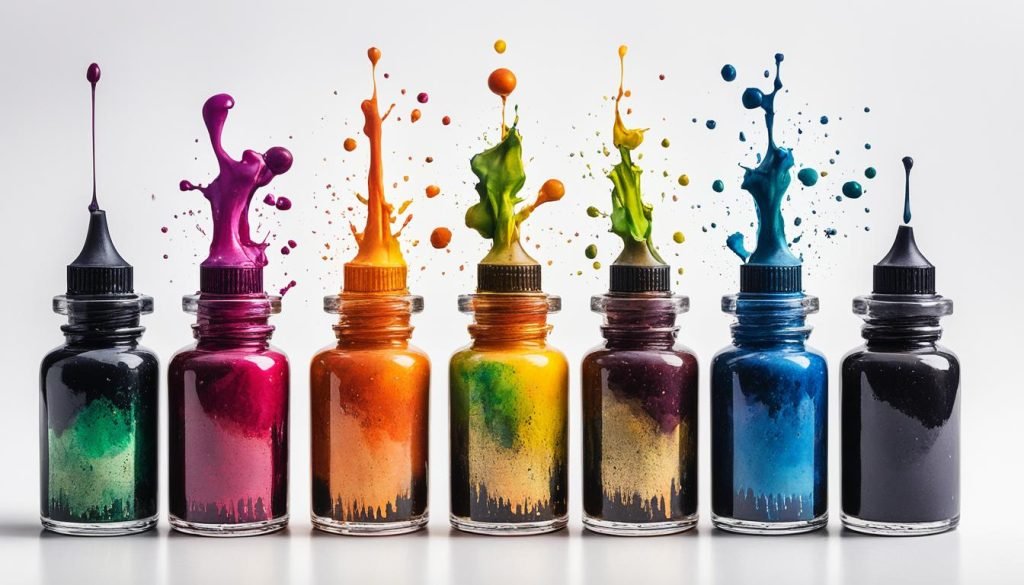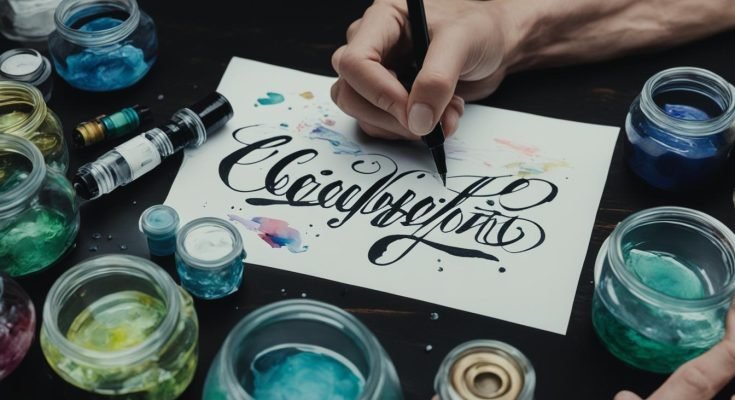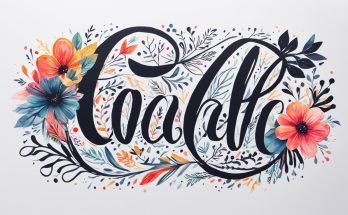Calligraphy Practice with Different Inks: Discover the Secrets to Mastering Your Art
When it comes to calligraphy, the ink you use plays a crucial role in the overall look and feel of your lettering. By experimenting with different ink types, you can not only enhance your calligraphy skills but also explore new techniques and create visually stunning compositions.
There is a wide variety of inks available for calligraphy, each with its own unique characteristics and effects on your writing. From India ink to sumi ink, walnut ink to acrylic ink, the options are endless. By practicing with different ink types, you can gain a better understanding of their qualities and how they can elevate your artistry.
So, why should you practice calligraphy with different inks? Firstly, it allows you to discover the best inks for your specific calligraphy style. Each ink has its own flow, drying time, and color intensity, which can greatly affect the outcome of your lettering. By experimenting with various inks, you can find the ones that suit your preferences and create the desired effect.
Secondly, practicing with different inks helps you improve your calligraphy skills. As you work with various inks, you’ll learn how they behave on different types of paper and how they interact with different nibs. This knowledge will allow you to make more informed choices when creating your calligraphy pieces and ultimately help you develop your unique style.
In this article, we’ll guide you through the process of practicing calligraphy with different inks. We’ll explore various ink types, provide recommendations, and share techniques to enhance your calligraphy skills. Get ready to take your calligraphy practice to the next level!
Key Takeaways:
- Experimenting with different inks can help you enhance your calligraphy skills and create visually appealing compositions.
- There are various ink varieties available for calligraphy, each with its own unique characteristics.
- Practicing with different ink types allows you to understand their qualities and how they affect your lettering.
- Choosing the right ink can significantly impact the outcome of your calligraphy.
- Regular practice with various inks helps you develop your unique calligraphy style.
Getting Started with Calligraphy Practice
Before you embark on your calligraphy journey and start experimenting with different inks, it’s essential to gather the necessary tools. Equipping yourself with the right calligraphy tools will set you up for success and help you hone your skills.
Calligraphy Tools for Beginners:
- Oblique holder: Investing in a good quality oblique holder is crucial for proper calligraphy technique. It allows you to hold the nib at an angle, enabling better control and creating beautiful, flowing lines.
- Ink: Choose high-quality inks with good flow and suitable drying time for smooth and consistent lettering. Experiment with different ink types to find the ones that suit your style and preferences.
- Good paper: Opt for calligraphy-friendly paper that is smooth and not too absorbent. This ensures your ink doesn’t bleed or feather, resulting in crisp and precise letterforms.
- Nibs: Selecting the right nibs is essential for learning calligraphy effectively. Look for nibs that are neither too flexible nor too rigid, striking a balance that allows you to achieve the desired line weight and control.
By having these essential tools at your disposal, you’ll be ready to dive into the world of calligraphy practice and unleash your creativity. Now, let’s continue exploring the fascinating realm of calligraphy ink types in the next section.
Exploring Different Ink Types for Calligraphy Practice

When it comes to calligraphy practice, the choice of ink plays a significant role in the outcome of your lettering. Different ink types offer unique characteristics and effects that can add depth and dimension to your calligraphic compositions. Let’s dive into some popular ink varieties and their distinct qualities.
India Ink
One of the most widely used and easily accessible inks for calligraphy is India ink. It is known for its ability to produce crisp and dark lines, making your lettering stand out with precision and clarity.
Sumi Ink
Originating from traditional Japanese calligraphy, sumi ink is prized for its rich black color and smooth flow. It allows for effortless strokes and subtle shading, adding elegance to your calligraphic pieces.
Walnut Ink
If you are aiming for a vintage aesthetic or antique-style calligraphy, walnut ink is a fantastic choice. With its warm brown tone, walnut ink creates a sense of nostalgia and age on your paper, giving your lettering a classic and sophisticated appearance.
Acrylic Ink
Acrylic ink is a versatile option that offers a wide range of colors and effects for your calligraphy practice. It can be mixed with other acrylic inks or diluted to create unique shades and gradients, giving you more creative freedom and opportunities to experiment.
Gouache
Gouache is another versatile ink that calligraphers love to explore. It is an opaque watercolor ink that can be used straight from the tube or diluted for more subtle tones. Gouache is known for its ability to create vibrant colors and allows for layering and blending to achieve stunning visual effects in your lettering.
Experimenting with these different ink types will allow you to find the ones that resonate with your calligraphy style and preferences. Each ink brings its own personality to your lettering, adding depth, texture, and character to your work. Whether you prefer the crisp lines of India ink, the elegance of sumi ink, or the vintage charm of walnut ink, there is an ink out there that will help you bring your calligraphy to the next level.
So go ahead, grab a variety of calligraphy inks, and let your creativity flow.
| Ink Type | Characteristics |
|---|---|
| India Ink | Produces crisp and dark lines |
| Sumi Ink | Rich black color with smooth flow |
| Walnut Ink | Warm brown tone for vintage feel |
| Acrylic Ink | Offers various colors and effects |
| Gouache | Opaque watercolor ink for vibrant lettering |
Techniques to Practice Calligraphy with Different Inks
Practicing calligraphy with different inks is an excellent way to enhance your skills and explore a variety of techniques. By experimenting with ink manipulation, you can add depth, texture, and visual interest to your lettering. Here are some techniques you can try to take your calligraphy practice to the next level:
Ink Dilution
One technique that can yield beautiful results is ink dilution. By adding water to your ink, you can create different shades and gradients in your lettering. Start with a small amount of water and gradually add more until you achieve your desired effect. This technique allows you to play with lighter and darker tones, adding depth and dimension to your calligraphy.
Ink Splattering
If you want to add a touch of creativity and texture to your compositions, try ink splattering. Dip a brush or toothbrush into your ink and use your finger or another brush to flick the bristles, causing the ink to splatter onto your paper. This technique can create a dynamic and visually appealing background or accent for your lettering.
Metallic and Shimmering Inks
To achieve a glamorous and eye-catching look, experiment with metallic or shimmering inks. These types of inks contain metallic pigments that reflect light, creating a lustrous effect on your paper. They’re perfect for adding a touch of elegance and sophistication to your calligraphy projects, especially for special occasions or invitations.
Brush Techniques
Using a brush instead of a traditional pen nib can open up new possibilities in calligraphy. With a brush, you can create expressive strokes, varied widths, and unique textures. Experiment with different brush sizes and bristle types to achieve a desired effect. Brush calligraphy is especially popular in East Asian calligraphy styles, such as Chinese and Japanese.
Combining Inks
Don’t be afraid to mix different types of inks to create your own custom colors and effects. Combining inks, such as mixing gouache and acrylic ink, can offer a wider range of colors and unique textures. This experimentation allows you to explore the versatility of each ink and create truly personalized calligraphy compositions.
Remember, the key to practicing calligraphy with different inks is to embrace the unique qualities of each ink and explore different application methods. By incorporating these techniques into your practice, you can enhance your calligraphy skills, create visually captivating compositions, and truly make your lettering stand out.
Conclusion
Practicing calligraphy with different inks is a fantastic way to enhance your script and elevate your artistry. By exploring various ink types and experimenting with their unique characteristics, you can unlock new techniques and push the boundaries of your calligraphy skills.
When practicing calligraphy with different inks, it’s important to choose high-quality tools and paper that complement the ink you are using. This ensures a smooth and enjoyable experience while allowing the ink to showcase its full potential. Embrace the versatility of different inks and have fun exploring the diverse effects they create on your lettering.
Regular practice and experimentation with various inks will enable you to improve and develop your own unique calligraphy style. By honing your skills and embracing the artistry of calligraphy, you can create visually stunning compositions that captivate your audience.
Start your calligraphy practice journey with different inks and discover a world of endless possibilities. Enhance your calligraphy artistry by embracing the beauty and versatility of various ink types. Enjoy the process, have fun, and let your creativity soar as you continue to explore the captivating realm of calligraphy.
FAQ
What tools do I need to calligraphy practice with different inks?
To practice calligraphy with different inks, you will need an oblique holder, ink, good paper, and the right nib. The oblique holder helps you hold the nib at an angle for better control. Choose inks with good flow and suitable drying time. Select a paper that is not too absorbent to ensure smooth and crisp lettering. And make sure to choose the right nib, neither too flexible nor too rigid, for effective calligraphy learning.
What are the popular ink types for calligraphy practice?
Some popular ink types for calligraphy practice include India ink, sumi ink, walnut ink, acrylic ink, and gouache. India ink is widely used and easily available, producing crisp and dark lines. Sumi ink, a traditional Japanese ink, is known for its rich black color and smooth flow. Walnut ink has a warm brown tone and a vintage feel, often used for antique-style calligraphy. Acrylic ink and gouache are versatile inks that can be mixed to create various colors and effects.
How can I practice calligraphy with different inks?
To practice calligraphy with different inks, you can experiment with ink dilution to create different shades and gradients. Ink splattering or using a brush can create textured effects in your compositions. Practicing with metallic or shimmering inks can help achieve a glamorous look. Embrace the unique qualities of each ink and explore different application methods to enhance your calligraphy skills.
How does practicing calligraphy with different inks enhance my skills?
Practicing calligraphy with different inks allows you to explore various techniques and improve your skills. By experimenting with different ink types, you can understand their qualities and how they affect your lettering. This experimentation helps you discover new techniques, push the boundaries of your calligraphy skills, and develop your unique style.
How can I improve my calligraphy artistry using different inks?
By practicing calligraphy with different inks, you can enhance your artistry. The versatility of different inks allows you to create diverse and visually appealing compositions. Experimenting with various ink types helps you develop a deeper understanding of their characteristics and effects on your lettering. With regular practice and experimentation, you can continue to improve and evolve your calligraphy style with different inks.




